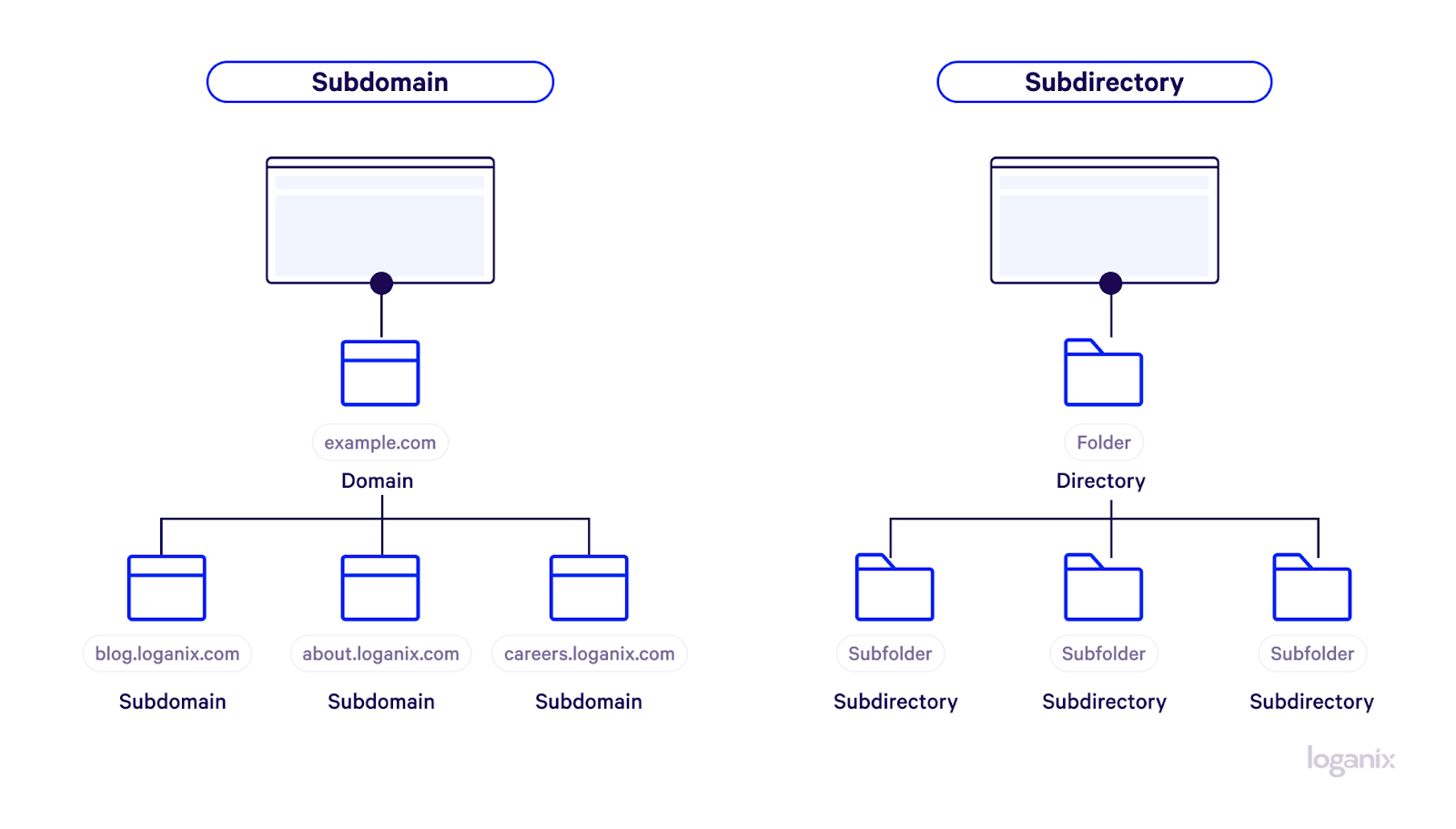What Is a Subdomain? Insights for Effective Website Structuring

Hand off the toughest tasks in SEO, PPC, and content without compromising quality
Explore ServicesAt first glance, subdomains may seem like a simple way to segment a website. But, delve a little deeper, and you’ll notice their relationship with search engines and their role in a website’s structuring is a touch more complex.
To catch you up to speed, in this guide, we’ll
- answer the question, “What is a subdomain,”
- break down the importance of subdomains,
- and dive into how to handle the potential challenges posed by subdomains.
What Is a Subdomain?
Subdomains are sub-sections of a website that function independently from the parent domain. This partitioning helps organize content, enhance user navigation, or set up separate sites for different use cases.
Perhaps, without even knowing, you’ve noticed a subdomain in a website’s URL. Subdomains appear before a parent domain as a prefix, separated by a period. For example, in the URL “resources.loganix.com,” “resources” is the subdomain of the parent domain, “loganix.com.”

This may be a touch confusing if you aren’t familiar with the anatomy of a web address. To give you a quick rundown, a URL’s “.com” portion is called a top-level domain (TLD). In our example, the “loganix” is called the second-level domain (SLD). That makes a subdomain a sub-section of the SLD.
Learn more: SEO glossary 250+ terms explained.
Why is a Subdomain Important?
Let’s see why subdomains are important to website structure and search engine optimization.
1. Enhances Website Organization and Navigation
Imagine you’re running a bustling online store that sells various products, including books, electronics, fashion, and much more. While the store is still young, you could simply organize these products into categories within a single-parent domain.
But, as the store grows and your product range expands, for the sake of organization and user experience, it may be worth segmenting your online store into different subdomains. This might look like “books.yourwebsite.com,” “electronics.yourwebsite.com,” or “apparel.yourwebsite.com.”
2. Facilitates Geo-Targeting and Personalization
Brands that work on a global scale and market to different regions of the world often use subdomains to separate their website’s content. Of course, these sites don’t exist, but just as an example, a brand like Toyota could use subdomains like “usa.toyota.com” to serve their customer base in the US, while a subdomain like “japan.toyota.com” could cater to Japanese customers.
This strategy of segmenting a website by region using subdomains allows companies that operate internationally to provide localized content in the local language with region-specific products or services.
Learn more: URL structure for SEO.
3. Boosts SEO with Specialized Content Hubs
Google treats subdomains as individual websites, which, in the right circumstances, can be a net benefit for your SEO strategy. For instance, with the right strategy, “blog.yourwebsite.com” could become a rich content hub, attracting backlinks and driving traffic without interfering with the performance of your main website. However, handling this with care is essential, as improper setup can lead to SEO issues like duplicate content (we’ll touch more on this below).
4. Allows for Experimentation and Innovation
Launching a new product line or even running a short-term marketing campaign is another scenario where subdomains come in handy. For example, “newproduct.yourwebsite.com” or “spring-sale.yourwebsite.com” can be an excellent sandbox.
A setup like this will allow you to create, test, and experiment without the fear it may affect your parent domain. Then, if the new product is a success, you can migrate the content to your new parent domain later. And so you don’t lose any SEO value like link equity, you can always redirect any top-performing pages to a URL housed on your parent domain.
For marketing campaigns, once the promotion is over, you can remove the subdomain without impacting the performance of your parent domain.
5. Provides Flexibility with Technical Setup
Subdomains also offer technical flexibility. For instance, you can host your parent domain and subdomain on different servers, allowing a multitude of configurations based on your specific needs. A setup such as this is particularly useful for large websites that receive a high level of traffic, where different sections of the site may require different hosting solutions.
So, what does this look like in practice?
Let’s say you run a popular tech news site that receives a significant daily traffic load. A good problem to have, right? Most certainly. Although, that isn’t to say a lot of traffic doesn’t come with its own challenges. For instance, perhaps your multimedia-heavy sections—like video reviews and podcasts—are slowing down your site’s load times due to their high server demands. A problem that neither your users nor Google are going to appreciate.
The solution? You guessed it, create a subdomain specifically for these sections. For example, “reviews.yourwebsite.com” or “podcasts.yourwebsite.com.” With these subsets of your website separate from your parent domain, you can optimize one server for video and audio content delivery and another for text-based content delivery. This approach will keep your audience and search engines happy with speedy page load times.
Learn more: page speed SEO.
Subdomain vs. Subdirectories: What’s the Difference?

Both subdomains and subdirectories play their part in website organization. However, they are fundamentally different from one another. Let’s quickly explore the differences between the two so you can choose the right choice for your website.
What Are Subdirectories?
Unlike subdomains, subdirectories, commonly referred to as subfolders, remain a part of the parent domain and are typically used to house different website sections like blogs, stores, or contact pages. You’ll no doubt have noticed them. For example, if you have a blog on your website, it looks like this: “/blog,” the entire URL appears like “yourwebsite.com/blog.”
Deciding Between Subdomains and Subdirectories
Your choice between subdomains and subdirectories will boil down to your website’s needs. For instance, if you’re creating distinct sections of your site that need separate server settings or you want to target different audiences, subdomains are probably the best fit.
However, if your goal is to maintain a unified SEO strategy across all sections of your site or you’re merely looking to organize your site’s content, subdirectories are the better choice.
Learn more: SEO subdomain vs. subdirectory.
Considerations When Using Subdomains
For all the benefits of subdomains, they aren’t without their challenges. The most important consideration is that search engines treat subdomains as separate websites, meaning you’ll have to build authority for each one. This, of course, takes time, effort, and investment.
Something else to consider is that subdomains can lead to duplicate content issues if not set up correctly. Duplicate content can harm your website’s SEO performance and lead to a drop in organic traffic.
With both of these potential problems in mind, if you decide to create a subdomain, it’s in your best interests to be sure you’re comfortable with starting a subdomain. If not, using a subdirectory or hiring a trained professional may be safer.
Conclusion
By now, you should feel like a subdomain superhero, ready to deploy subdomains (or subdirectories) to organize your website, target different audiences, and optimize your online presence.
But remember, even superheroes could use a sidekick… Ahem-hem, hellooo. It’s us, Loganix!
At Loganix, we’re more than just your go-to SEO experts—we’re also your partners in digital success. We know the ins and outs of domain structures, SEO strategies, and everything in between.
🚀 So, if you’re ready to take your website to the next level, reach out to us today! 🚀
Hand off the toughest tasks in SEO, PPC, and content without compromising quality
Explore ServicesWritten by Brody Hall on October 20, 2023
Content Marketer and Writer at Loganix. Deeply passionate about creating and curating content that truly resonates with our audience. Always striving to deliver powerful insights that both empower and educate. Flying the Loganix flag high from Down Under on the Sunshine Coast, Australia.





